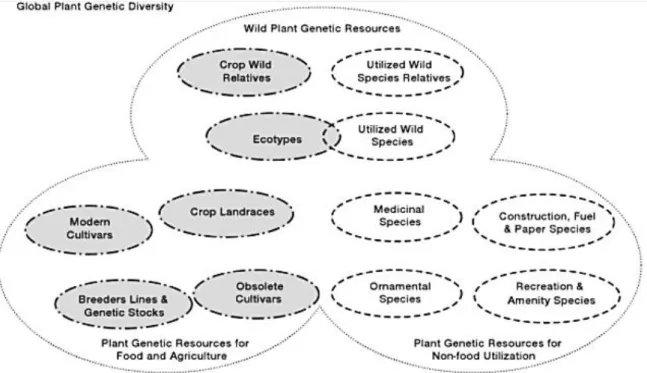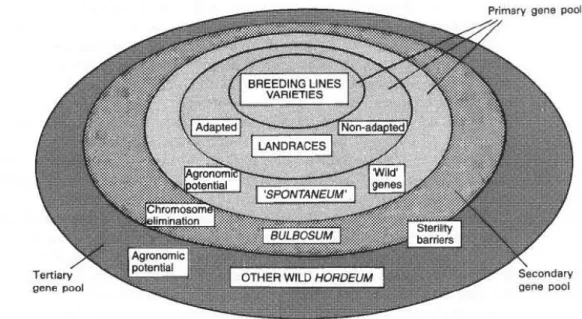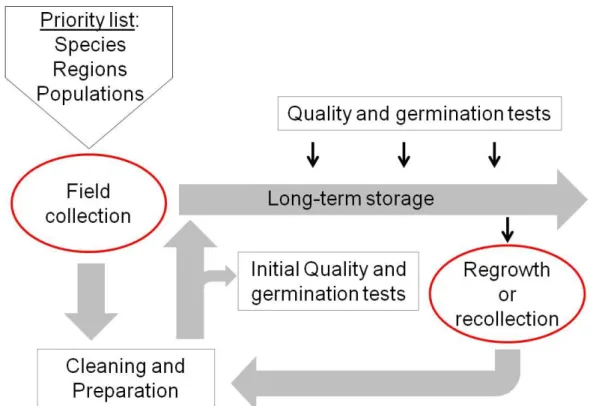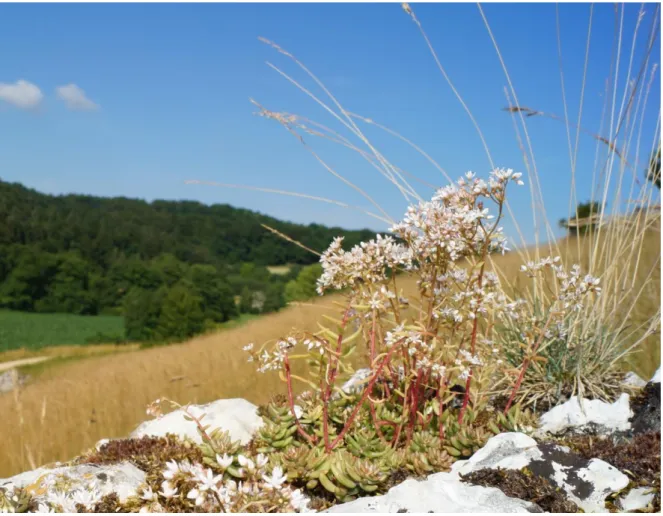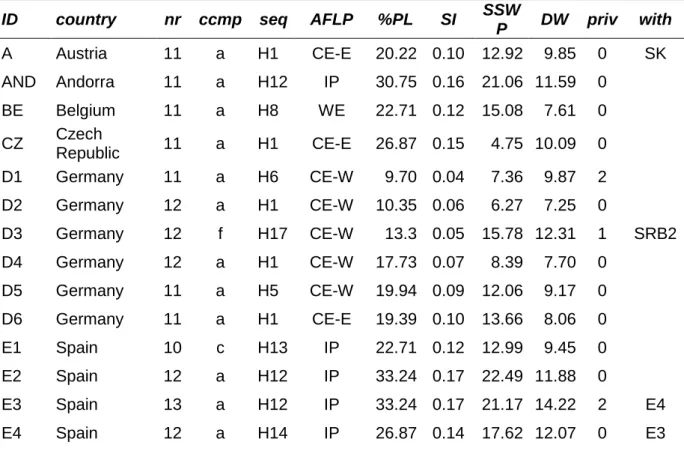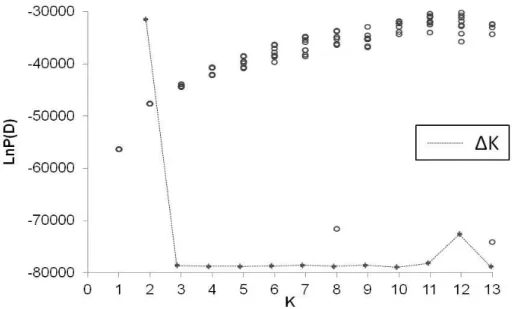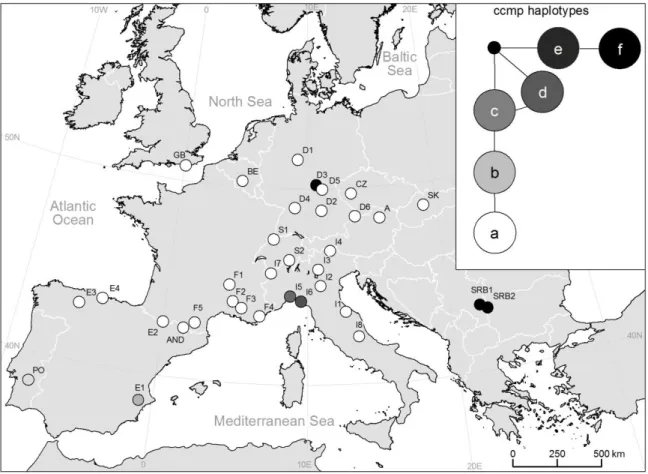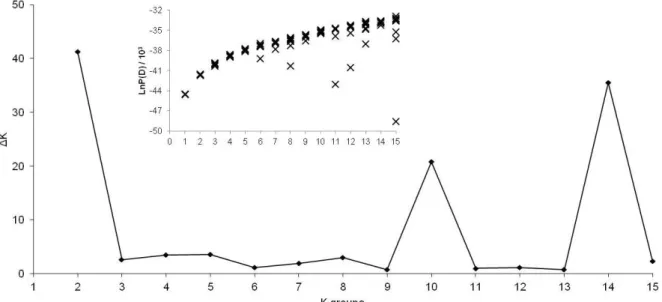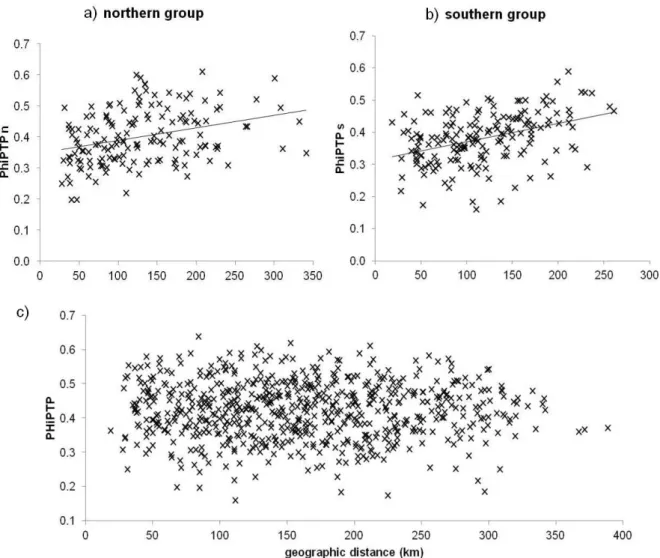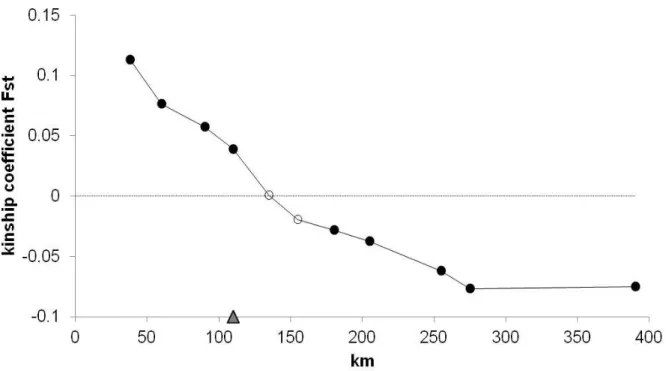The geographic scale of genetic variation in common plant species –
Implications for genebanks and restoration
DISSERTATION ZUR ERLANGUNG DES DOKTORGRADES DER NATURWISSENSCHAFTEN (DR. RER. NAT.)
DER FAKULTÄT FÜR
BIOLOGIE UND VORKLINISCHE MEDIZIN DER UNIVERSITÄT REGENSBURG
vorgelegt von Daniela Maria Listl
aus Regensburg
im Jahr 2016
ii Das Promotionsgesuch wurde eingereicht am:
01.07.2016
Die Arbeit wurde angeleitet von:
Prof. Dr. Christoph Reisch
Unterschrift:
iii Für meine zwei Deifln
und meine Eltern
iv
v TABLE OF CONTENTS
Acknowledgements……… vii
Summary……….. ix
CHAPTER 1 GENERAL INTRODUCTION………...………..……… 1
1 Biodiversity………... 1
> Excursus: Genebanks worldwide – a short overview……… 4
2 Genebank standards………... 8
4 Thesis outline………... 11
CHAPTER 2 PHYLOGEOGRAPHY OF A TOUGH ROCK SURVIVOR IN EUROPEAN DRY GRASSLANDS……… 15
Abstract………... 15
Materials and Methods……….. 18
Results ……… 25
Discussion………... 33
CHAPTER 3 THE GEOGRAPHIC SCALE OF GENETIC VARIATION IN A COMMON SPECIES – A CASE STUDY ON LATHYRUS PRATENSIS L.………...…... 38
Abstract………... 38
Introduction ………... 39
Material and Methods ………. 41
Results………... 50
Discussion ………... 56
CHAPTER 4 GENETIC DIVERSITY IN POPULATIONS OF HEPATICA NOBILIS SCHREB. IN BAVARIA AGAINST THE BACKGROUND OF SEED TRANSFER GUIDELINES IN FORESTRY AND RESTORATION... 60
Abstract ………... 60
Introduction………... 61
Material and Methods ……….………... 65
Results………... 70
Discussion …..………... 74
vi CHAPTER 5
GENETIC ADAPTATION AND ENVIRONMENTAL INFLUENCES ON SEED QUALITYAND
LONGEVITY……… 80
Abstract ………... 80
Introduction ………... 82
Material and Methods ………... 84
Results ...………... 93
Discussion………... 99
CHAPTER 6 GENERAL DISCUSSION AND CONCLUSION………... 103
History of plant populations ……… 103
Plant traits………... 104
Intraspecific differences in seeds………... 105
Strengths and limitations ………... 105
Conclusion and Perspectives ………... 107
References………...……….. 109
Appendix………. 130
vii ACKNOWLEDGEMENTS
General Acknowledgements
First, I would like to thank Christoph Reisch and Peter Poschlod.
Christoph was there, even before start, over up and downs, to the end of this thesis – he was always supportive and with some new ideas and background information
– and almost always positive ;-) I thank you very much!
Peter Poschlod was trustful and supportive all the time – even at the beginning, when he did not really know me. I appreciate this very much! His knowledge is impressive and all his suggestions for the thesis were very helpful!
Petra Schitko was always contact person number one in the lab: next to her knowledge and experience, she has this kind of steadiness and confidence – and she brightens up lab work even in moments when nothing is working. For very pleasant co-working in the lab – and for tolerating my small nervous breakdowns I also want thank Eva very much.
I want to thank Peter Hummel, Manuela Bog, Salvatore Tomasello, Roland Greiner, Sven Himmelreich and the whole working group Oberprieler for help, when there was help necessary!
Special thanks also go to the partners of the Genbank WEL and WIPs in Osnabrück, Karlsruhe (KIT und PH), Berlin, esp. Peter Borgmann, Annemarie Radkowitsch, Joachim Daumann, Elke Zippel. I am deeply grateful to Judith Lang, Philipp Glaab and Conny Straubinger - they were doing a very good job at the genebanks in Regensburg. It is a pleasure to work with you!
A big thanks also goes to Sabine for a lot of help and instructions to ArcGIS!
Thanks to the whole Regensburg group for their pleasant mix of spirits that was inspiring and very enjoyable: esp. Annika Sezi, Annisa Satyanti, Bille Bauer, Christina Meindl, Christina Putz, Christina Gleixner, Christine Gutmann, Christoph Schmid, Ellen Pagel, Eva Bauer, Eva-Rosa Wagner, Günther Kolb, Hannah Gutheil, Heike Pfaffenzeller, Irina Weinberger, Juliane Drobnik, Katrin Binder, Maik Bartelhaimer, Maxi Bleicher, Mehdi Abedi, Sabine Fischer, Sabrina Senger, Sergey Rosbakh, Shuang Li, Steffi Meier, Tobi Maul, Tobi Windmaisser, Verena Busch – and many, many more! And a special thanks to my wonderful roommates Franzi Kaulfuß and Josef Simmel!
I want to thank my friends: Susi, Gudrun, Babsi, Bine, Susanne, Carola, Christiane, Birgit, Andi H., Andi N., Axel, Falk, Francis, Geimi, Karsten, Lugge, Lukas, Markus, Michi, Olla, Roli and all the “Sinzinger” and “Prüfeninger” that made it possible to think about something else – and they even gave me company at collection trips and gave me bed & breakfast all over Bavaria and Europe.
viii My family has supported me during the long time of preparing this thesis. My parents Helga and Paul have always been very supportive - financially and morally, “Oma Maria” und “Oma Helga”
have been there for us each day for three years now.
Of course, I am very grateful to my partner Basti: he accompanied collections trips for all of the chapters during his holidays – without him I would not have been able to start this neither to bring this to an end!
Finally, thanks to Theo - you have been very patient with your confused mother!
Chapter 2
A lot of people collected plant material for this chapter: Andreas Hilpold, Andreas Renner, Annemarie Radkowitsch, Anton Meier, Camilla Wellstein, Carla Pinto Cruz, Christiane Sonnleitner, John Dickie, Helga Listl, Maria Hanauer, Melanie Harze, Nicola Schoenenberger, Paul Listl, Petr Karlik, Roland Kittel, Salvatore Tomasello, Sven Himmelreich, Zsolt Molnár, - thanks a lot to everyone! Special thanks go to Simone Tausch and Martin Leipold for collections in Serbia and Spain, and the organization of several other collections! For helpful tips on the manuscript we thank two anonymous reviewers.
Chapter 3
Thanks to Sebastian Teufel for the help at several collection trips all over Bavaria. For help with statistics I want to thank Christina Meindl. Prof. Christoph Oberprieler gave me very helpful hints on ploidy levels of Lathyrus pratensis - thank you a lot! Further, Kathrin Kiehl and three anonymous reviewers made helpful comments on the manuscript.
Chapter 4
Sincere thanks goes to Katrin Binder for collection of plants and lab collaboration that was very pleasant. For plant collection I also want to thank Sebastian Teufel; and of course a big
“Thanks” to Shuang Li for her very, very ambitioned work in the lab!
Chapter 5
I thank Sergey Rosbakh for collaboration of the projects and for taking me with him to Berchtesgaden several times. Thanks to Simone Tausch and Martin Leipold for the collaboration in obtaining information and material (Martins brother for help with the boxes!).
Josef Simmel, Juliane Drobnik and Philipp Glaab helped with the collection of seeds – thank you a lot. I further want to say “Thank you” to Volker Debus and the gardeners for fostering the plants - and to famous Inge Lauer for her help in the lab and a lot of washing! Last but not least, I want to thank Christoph Schmid for his generous help with statistical analysis in R!
ix SUMMARY
Genebanks for plant seeds are a necessary tool to support the conservation of biodiversity. In the last decades also the importance of intraspecific diversity within the genebank collections was emphasised. Even though background information on the distribution of genetic diversity within and between populations was scarce for common plant species, seed provenances have been delineated for seed collection and production. Seeds have to be used in the same provenance, where they were collected for restoration projects, agriculture and forestry.
The present study aims to elucidate distribution of intraspecific genetic diversity in three common plant species over different geographic scales. In the last part, further intraspecific differences in seed traits were investigated.
Chapter 2 dealt with the distribution of genetic diversity within and between populations of Sedum album in its distribution range in Europe and the history of Central European populations. With a combination of neutral and chloroplast specific markers, we reconstructed postglacial processes that lead to the present distribution pattern in S. album. Distinct haplotypes could be detected on the Iberian Peninsula and in Eastern and Southern Europe.
Central European populations have their origin in Southern Europe and show meanwhile high influence of Eastern lineages. A clear East/West subdivision was found with hybrid zone in Western Europe. Glacial refugia have been detected on the Iberian Peninsula and in the mountains of Liguria (Northern Italy). Further refugia can be assumed in south-eastern Europe.
In chapter 3 and 4 we used AFLP markers to examine the distribution of genetic diversity in and between populations of Lathyrus pratensis and Hepatica nobilis in Bavaria. Correlation of genetic diversity with seed provenances was tested. The studies of two perennial, cross- pollinated plants revealed differences in genetic diversity within and between populations. In L.
pratensis within population diversity was ordinary compared to other plants with similar life history traits. However, differentiation between populations was very high, what can be ascribed to the limited dispersal of the heavy seeds. Moreover, the influence of nearby anthropogenic populations can, therefore, be excluded. Gene flow was present within 110km, resembling the northern and the southern part of Bavaria (delineated by the river “Danube”). We found that the group of populations in southern Bavarian is located in and delineated by one of the official seed production areas. For L. pratensis the production zone is sufficient. Nevertheless, material for restoration should be taken as near as possible due to high differentiation between populations. Collections for genebanks should be undertaken from both northern and southern
x Bavaria, with an emphasis on southern parts, where genetic variation within populations was higher.
For H. nobilis, there were no correlations with official provenances or production zones. Gene flow was very limited, obviously due to the seed dispersal by ants, which agitate within few square metres. Genetic diversity within populations was high, while differentiation between populations was moderate. The pattern can be explained by random, long-distance dispersal, e.g. of plants, which have been used in horticulture for many centuries. Because ex-situ storage of seeds is difficult for H. nobilis, it is important to conserve high variation in in-situ populations in old forests.
Intraspecific differences in seed traits were examined in chapter 5. Seed quality and longevity were tested in two experimental setups. We measured percentage of filled seeds with x-ray analysis, 1000-seed-weight, initial and maximum germination rates to infer seed quality. To measure longevity seeds were conducted to accelerated aging. We collected data from wild lowland and alpine populations and from common garden populations, which were cultivated from seeds of the same populations. Percentage of filled seeds and seed weight was not different for lowland and alpine, or wild and common garden populations. Nevertheless, initial and maximal germination was higher in seeds from wild populations. Further, longevity tended to be higher in seeds from lowland than alpine and common garden than wild populations, respectively. Nevertheless, we could show that differences in longevity are environmentally influenced to some extent, because common garden populations of different origin differed less than wild populations.
In a second setup, seeds were collected in consecutive years from the same populations. Seed data were compared with climate data. We used model approaches based on results of former studies. Mean annual temperature and total annual rainfall, and mean annual temperature together with total rainfall and total sunshine within 90 days prior to harvest explained some variation in our data.
In chapter 6, I conclude that history of populations and plant traits have more influence than recent anthropogenic events on the distribution of genetic diversity in common plants. For conservation of intraspecific diversity in common plants, plant traits should be considered in collections for genebanks and in the usage of seeds for restoration. The collection of more data concerning quality and longevity of wild plant species would improve future collections. Costs for testing, regrowth and recollection in genebanks would be reduced.
Chapter 1 General Introduction
1
Chapter 1
General Introduction
Ex-situ conservation of plants has a long history. Monasteries and botanical gardens have cultivated ex-situ populations since the 16th century (Hurka et al. 2008). Besides living cultures, they stored and exchanged seeds of rare or medicinal species. The oldest institution that intentionally practiced seed storage (“genebanking”) is situated in St.
Petersburg, where N. Wawilow started to store seeds from worldwide collections in the early 20th century (Hammer & Diederichsen 2009; Laarz 2014; Nick 2014). In the 1960s Cesar Gomez-Campo has opened “Banco de Semillas de la Escuela Tecnica Superior de Ingenieros Agronomos de Madrid” – the first seed genebank for wild species (Pignone &
Hammer 2010).
The enhanced longevity of dry and cold stored seeds is helpful for institutions all over the world and cost-effective genebanks were established (see below: Excursus). Nowadays, genebanks provide a general backup for mankind – the last chance of survival for threatened species, the insurance against global warming, environmental disasters and wars - and a possibility to solve the nutrition of a growing world population (CBD 1992; FAO 2010; Schoen
& Brown 2001). It seems easy to restore the biodiversity of plants with storage of some small seeds, it gets difficult when it comes to details.
1BIODIVERSITY
Three levels of diversity, namely diversity of ecosystems, of species, and of genes have been defined and are often quoted by research and politics (CBD 1992; Gugerli et al. 2008).
When conservation of plants’ biodiversity is considered, priorities and conservation strategies have to be set in all levels.
1.1 Ecosystem level
Whole ecosystems worldwide are under enormous pressure. Arable land is economically and for immediate survival often more relevant than ecologic diversity (Mangel et al. 1996; Negri et al. 2009). Ecosystem ingredients, like fresh water, soil fertility, and fibre are often
Chapter 1 General Introduction
2 removed, while other factors like input of waste, increase of certain chemicals, and the fragmentation of landscapes perturb important processes (Pagiola et al. 2004). It is clear that ecosystem conservation has to consider flora and fauna, and, moreover, all the interactions and processes agitating in and between ecosystems. Nevertheless, too few things are known about those complicated networks (Heywood & Iriondo 2003; WallisDeVries et al. 2002).
For conservation priorities of ecosystems different points of view and interests set their focus on different values. Economic or ecologic factors can be prioritised for the evaluation of ecosystems (Pagiola et al. 2004; Williams 2007; Wilson et al. 2007). Ecosystem services, including the climate regulation, fresh water purification, detoxification, recirculation of waste, providing of fodder, fibre, and biomass are meanwhile highly evaluated aspects of ecosystems (Wilson 2003) p. 106). Further, species richness is a widely accepted evaluation factor (Williams et al. 1996; Wilson 2003). The more species ecosystems harbour, the more stable and productive they are (Wilson 2003) p. 108). Species hotspots are, therefore, conservation priorities, e.g. the 25/34 plant hotspots, where 44% of all vascular plant species of the world are residing on only 1.4% of the earth’s surface (Li & Pritchard 2009). Besides, rarity of species inhabiting an ecosystem can be a deciding factor for conservation (Williams et al. 1996). Within specific areas, furthermore, the principle of complementary sets is applied for conservation, in which most of the species should be present at least in one of the protected ecosystems (van Jaarsveld et al. 1998).
Seed genebanks can help to maintain plant biodiversity in ecosystems by conservation of threatened species or certain ecotypes (see 1.2 and 1.3), which can be used for restoration and recolonisation of ecosystems. Nevertheless, conservation of ecosystems is only possible in-situ. Ex-situ conservation, like seed genebanks, can start in the next level: the species level.
1.2 Species level
There is a large number of threatened plant species. Those have been in focus for ex-situ conservation for a long time as life-sustaining measure to prevent their total extinction: Based on IUCN Red List (2014) out of 268000 flowering plants 9905 (7%) are critically endangered, endangered or vulnerable (IUCN 2014). CBD stated that 75% of threatened species should be stored in ex-situ collections until 2020 (CBD 2010; GSPC 2012). In future, those accessions can be irreplaceable, when it comes to restoration or recolonisation.
Chapter 1 General Introduction
3 Independent of the degree of threatening “living material that includes genes of present and potential value for humans” should be preserved (CBD 1992). Plants or parts of plants that can be propagated (generatively or vegetatively) are called plant genetic resource (PGR).
This group comprises a wide range of species (Fig. 1), including plants – classified as non- foods - with high economical relevance (e.g. Bambus, Brassica napus oleifera, Elaeis guineensis, and Gossypium), worldwide recognized medical used species (Aloe, Chamomilla, Eukalyptus, and Echinacea), and many species used in distinct regions for traditional medicine.
Economy and pharmacy are constantly in search of new raw material and substances. It is often stated that there are numerous species containing still unknown substances and ranges of application worthwhile in future (Farnsworth & Soejarto 1991; Mendelsohn & Balick 1997). Those species – not acknowledged as PGR by date – could be highly relevant in future (e.g. see the case of Fontainea picrosperma: (Campbell et al. 2014)
Fig. 1: Plant genetic resources comprise a wide range of global plant diversity, from Maxted (2008).
Chapter 1 General Introduction
4 The main part of PGRs are plants for food and agriculture. Even, if only 15 species account for 90% of human nutrition (rice, maize, wheat and potato alone for about 65%) and only some hundred contribute significantly, more than 30.000 are edible (FAO 1994; FAO 1995).
Next to obvious PGR plants, there is a high number of wild plant genetic resources with possible use, for example, plants that are closely related to crop plants. Those are called
“crop wild relatives” (CWR) (Maxted et al. 2006; Maxted et al. 2012; Parra-Quijano et al.
2012). By definition of Maxted et al. (2006) „a crop wild relative is a wild taxon that has an indirect use derived from its relatively close genetic relationship to a crop…“. Those species
“have particular values because of their potential to contribute beneficial traits to crops, such as biotic and abiotic resistance, leading to improved yield and stability" (Maxted et al. 2006).
It was shown that CWRs already have high economic influence as they account for 37.3*10^6 € of the agricultural production of 29 priority crops in the Millennium Seed Bank (PwC 2013).
A main part of wild species can not only be of use because of their relation to important PGR plants, but they are considered as PGRs themselves. Some are not widely used at the moment, but they have potential to be useful in future. In Germany out of about 3600 wild species about 1000 are evaluated as PGRs in this sense (BLE 2014; Hurka et al. 2008).
Moreover, 1.800 plants with high horticultural or ornamental use can be added to the number of PGR species in Germany.
Most wild species have not only one usage, but they can be taken for several advantages.
When wild species have to be prioritised the number of usages can be a deciding factor.
Based on Schlosser et al. (1991) wild species in Germany are classified in 13 categories:
agricultural and food plants, bee food plants, carbohydrate suppliers, fodder crop, forest trees, fruit and vegetable, horticultural and ornamental plants, medicinal and spice plant, oil suppliers, plants with breeding purposes, plants with technical use (e.g. as dye, energy supplier, fibre plants), protein suppliers and windbreaking and shadowing plants are conducted for the species status as PGR (BLE 2014; Poschlod et al. 2014; Schlosser 1991).
Symphytum officinale, for example, is considered in six categories as medical, fodder and edible plant, as bee food plant and for horticulture and breeding purposes.
> Excursus: Genebanks worldwide – a short overview
The long-term ex-situ conservation of seeds has started with the help of worldwide genebank initiatives with different collection strategies. Starting with Wawilow genebank (320000
Chapter 1 General Introduction
5 species, mainly CWRs, Russia), nowadays about 1750 genebanks are officially registered worldwide, which contain about 7.4 million accessions (FAO 2010). The most popular storage place is Svalbard Global Seed Vault, managed by the Global Crop Diversity Trust with 820000 accessions from all over the world (Breen 2015). Established seed genebanks that deposit their “backup” seeds in the “Trust” are e.g. the international agitating Millennium Seed Bank with 34.000 species (GB, www.kew.org/) and the Leibniz-Institut für Pflanzengenetik und Kulturpflanzenforschung (IPK) with >150000 accessions of 3200 crops species (Germany, http://www.ipk-gatersleben.de/).
Nevertheless, most genebanks are species or region specific. This makes perfect sense as it is efficient - especially for small institutions - to restrict collections to certain areas and/or the management to certain species.
Staple foods are for many genebanks the priority group of collections, e.g. the International Crops Research Institute for the semi-arid Tropics (ICRISAT) holds 123.000 accessions of sorghum, pearl millet, chickpea, pigeon pea and groundnut from 144 countries (Asia and Africa, http://www.icrisat.org/) and in the International Rice Research Institute (IRRI) 177.000 types of rice are deposited (Philippines, www.irri.org/).
Broader collections, but still with focus on staple foods are the National Small Grains Collection (NSGC) with the biggest collections of wheat (>856.000 accessions), barley (>466.000 accessions) and oat (>130.000 accessions) (South Africa, www.arc.agric.za/arc- sgi/Pages/Germplasm%20Development/National-Small-Grain-Collection.aspx), and the International Institute of Tropical Agriculture (IITA) holdings >28 000 accessions of major food crops of Africa (Nigeria, www.iita.org/).
Even though, only a few genebanks have their priority in wild species, the number is growing with a growing interest from conservation, seed producers, pharmacy, and breeders. The intention to collect region-specific, endemic, and threatened wild species have Western Australia Seed Technology Centre (WASTC), which harbours > 3500 Australian species (Australia, http://www.bgpa.wa.gov.au/about-us/research/wa-seed-tech-centre) and Genbank Bayern Arche with a collection of 500 threatened wild species from Bavaria (Germany, www.genbank.ur.de). Collections, which contain wild species accounting as PGR are National Plant Germplasm System (NPGS), which collects crop and CWR species worldwide (USA, www.ars-grin.gov/npgs/), Plant Genetic Resources of Canada (PGRC) with 110000 accessions of all kind of bred and wild plants (Canada, http://pgrc3.agr.gc.ca/index_e.html), European Native Seed Conservation Network (ENSCONET) with only wild species (Europe,
Chapter 1 General Introduction
6 http://ensconet.maich.gr/), and Genbank für Wildpflanzen für Ernährung und Landwirtschaft (WEL) for unthreatened and wild PGR species in Germany (Germany, www.genbank- wel.de).
1.3 Intraspecific/ Gene level
Conservation of genetic diversity and, therefore, intraspecific diversity is a main level in plant conservation and worldwide politically acknowledged since ratification of the CBD (1992).
Intraspecific diversity of plant species comprises all levels of evolutionary divergence, subspecies and adaptations (CBD 1992; Moritz 2002). Nevertheless, conservation of biodiversity mainly focuses on ecosystems and species (Moritz 2002). In the last years, it has been shown that landraces of some species have become enormously threatened by genetic erosion due to the replacement by high productive breeding lines in many regions (Negri et al. 2009).
Many cases of adaptations in wild populations have been described that can be useful for breeding.
Cassava (Manihot esculenta) harvests in several parts of Africa were decimated by cassava mosaic disease since 1988. Naturally resistant lines were identified in different genebanks and could help to overcome the crisis partly (FAO 2014b; Otim-Nape et al.
1994).
With a local variety of Triticum that was collected in 1948 in Turkey, it was possible to gain resistance against pathogens (Laarz 2014).
In Germany a project is conserving the last wild populations of Vitis vinifera ssp. sylvestris, the wild relative of vine (Vitis vinifera ssp. vinifera), which already helped breeders to acquire natural resistances against several diseases (Nick 2014).
An accession of soy from the Wawilow genebank in St. Petersburg showed resistance against a pathogen that infested US soy beans. A new soy breed was created and is cultivated all over US America today (Laarz 2014).
The Alb-lentil was cultivated until the middle of the 20th century in the Swabian Alb. Two of the main breeds were lost, after the cultivation was quit due to more rentable cultivation of wheat and sugar beet, or cattle breeding (Poschlod 2015). In 2006 some seeds of these cultivars were found in the Wawilow genebank. At first some hundred seeds were cultivated in 2007 to increase the number of seeds. Nowadays the lenses are sold as speciality from the Swabian Alb-region (Fideghelli & Engel 2008).
Chapter 1 General Introduction
7 It was further shown that plant traits, chemical compound included, differ between habitats (Forwick et al. 2003; Rieger et al. 2008) (see also chapter 5). In wild populations of the pharmaceutical relevant Arnica montana chemical compounds differed with ecological parameters (Seemann et al. 2010). For pharmaceutical and medicinal use of the plants the chemical composition of these compounds is an important factor. In future, as much diversity in plant traits as possible should be accessible in PGRs.
For collections of PGRs the prioritisation in intraspecific diversity needs further attention:
basis of the “gene pool concept” is the degree of kinship to the “main crop”, the possibility of gene transfer and the production of fertile offspring (Harlan & de Wet 1971). The high priority crop Hordeum vulgare was used as example by Von Bothmer & Seberg (1995) (see also Fig.
2). The primary gene pool consists of all breeding varieties and landraces (farmers’ races or traditional breeds). Secondary gene pool would be the wild forms of the species H. vulgare ssp. spontaneum and the directly related species H. bulbosum, which are possible to crossbreed with breeding lines of H. vulgare. Furthermore, other wild related species should be collected for future breeding purposes as tertiary gene pool. With this classification a main part of the whole gene pool, namely secondary, tertiary gene pool and even the wild form in the primary gene pool, have to be collected in wild populations.
Fig. 2: Gene pool of H. vulgare, from Von Bothmer & Seberg (1995) derived from gene pool concept ofHarlan & de Wet (1971).
Chapter 1 General Introduction
8 From breeding lines to landraces it is obvious, which “populations” have to be chosen for conservation collections. It gets more difficult, when it comes to CWRs, which are represented by tertiary, secondary and part of the primary gene pool. In Germany 4211 species are CWRs by definition (Kell et al. 2008). For rare or geographically restricted species all populations should be included in conservation purposes. For common species a prioritisation has to be made (see 3). Genebank guidelines specify and laws define limitations for collections of wild species, but those regulations are often ambiguous or lacking in background information.
Collections with high intraspecific diversity contain high diversity in seed traits, too. In wild species all life cycles (germination, flowering time, time of seed dispersal, dormancy) are adapted to the environmental conditions and differ between habitats and populations. It is important for collections to restore those adaptations, when they are genetically determined.
Nevertheless, different environmental conditions also cause differences in seed quality and longevity (Mondoni et al. 2014; Mondoni et al. 2011; Probert et al. 2009). High quality and long lived seeds can be stored over long time periods without the necessity of testing, recollection or regrowth. Especially the knowledge about longevity of seeds is crucial to avoid the loss of the accessions. In cultured plants, also seed quality is optimised and overall longevity is well known. Several long-term storage data have been analysed over the last years e.g. (Hong & Ellis 1996; Nagel & Börner 2010). They all found that longevity under genebank conditions is species or family specific. Those studies also emphasise intraspecific differences in longevity that should be acknowledged, when it comes to determine the time of renewing the accession. In wild species, which are characterised by high intraspecific variation in other traits, also longevity and quality shows high differences between accessions (FAO 2014a).
2GENEBANK STANDARDS
The knowledge about genebank management is growing with each collection. Several genebanks in different regions of the world described their findings for their range of species or collection area. General procedures are similar for all genebanks (Fig. 3). Most genebanks refer their strategies for collection and management to certain standards that describe all steps of genebank management, like ENSCONET (ENSCONET 2009b; FAO 2014a; ISTA 1999). Advises of standards for field collections are inconsistent, especially, when it comes to
Chapter 1 General Introduction
9 wild species that are not restricted to certain regions and populations, but common and widely distributed. Concrete instructions concerning numbers of collected populations and even delineation of populations are very ambiguous (Neel & Cummings 2003).
For cleaning and preparation (drying included), as well as for long-term storage conditions of orthodox seeds guidelines are concordant. Quality and germination tests should be done by the genebanks regularly, but this depends on their species pool and their available resources. Intraspecific variation in the time, when seed quality steps beyond a certain percentage of viability, is hardly acknowledged. The adjustment of regrowth or recollection, therefore, is sometimes difficult.
Fig. 3: Overview over important steps in genebank management. Red circled steps are objectives of the thesis at hand.
Guidelines for planning of field collections have to serve different aspects and, therefore, differ a lot. Overall, suggestions are made for regions and the number and extent of populations that should be collected (ENSCONET 2009b; FAO 2014a). On one hand bias should be avoided, i.e. collections should not be made too close (Hijmans et al. 2000) to prevent a wasting of resources (storage place, labour time and money). On the other hand
Chapter 1 General Introduction
10 as many adaptations as possible should be collected to restore the main genetic diversity of each species. Important gene pools or areas should be represented. A limited sample of populations should represent a maximum amount of useful genetic variation in the species (Crossa & Venkovsky 2011; Marshall & Brown 1975).
One example, based on phenotypic diversity, is given by Ortiz et al. (1998). The authors indicate to restore 103 populations as „core“-collection of Chenopodium quinoa. Since the late last century genetic studies can be found in literature. Nevertheless, the intention of these studies and, therefore, the collection strategy and number of collected populations differ: 1-5 populations of endangered species are recommended, but differentiation and ecotypes have to be acknowledged (Briggs & Walters 1984; Brown & Briggs 1991; Guerrant et al. 2004). Alike, Falk & Holsinger (1991) suggest that 5 populations over the geographical range should be sufficient, which account for 67-83% of all alleles of four globally rare taxa (Neel & Cummings 2003). In contrast Guerrant et al. (2004) advise to collect in 50 populations over the whole geographical range. 53%-100% of all populations must be sampled to get all alleles with frequencies of > 5% according to Neel & Cummings (2003), who tested four rare species.
First and basic problem for wild and common species is the definition of a population. It is sometimes hardly possible to define strict borders of populations for common and widely distributed species. Different theories have been developed, of which the “gamodeme” theory (Briggs & Walters 1984) has to be mentioned, which is very similar to the Mendelian or panmictic populations (Silvertown & Lovett Doust 1993). Hereby, a population is the landscape unity in which free gene flow is possible. The distances of seed and pollen dispersal, at best in combination with genetic studies, can help to define such unities. It has been shown that populations classified by this definition are quite small and restricted for most plants (Briggs & Walters 1984; Ehrlich & Raven 1969). Even, if species are distributed quite homogenously over a wide area, samples should be taken within relatively small distances (isolation by distance effects) and held separate (Von Bothmer & Seberg 1995).
Only few genebanks have the possibility to operate globally. Most projects are conducted within restricted landscape areas or within political boundaries. The priority of collection areas and populations has to be defined within these areas. At least ecogeographic surveys should always be supplied before collection trips are planned (Von Bothmer & Seberg 1995).
However, background studies are not always possible or reasonable: For common wild species, there is a problem to get funding for background studies, because there is no
Chapter 1 General Introduction
11 obvious threat and no need to investigate population diversity in central distribution areas.
Nevertheless, based on former explanations, we see that collections without prior knowledge are not advisable.
Guidelines for seed testing are based on certain family or species-specific traits. Long-term studies and artificial aging give a good idea of the time range, in which a collection should be renewed (Nagel & Börner 2010; Nagel et al. 2010).
Nevertheless, it was also described that quality and longevity of wild species showed high intraspecific differences (Probert et al. 2009). Differences are often caused by conditions at collection or prestorage, which are the most sensitive phase for damages of the seeds (Rao et al. 2006). Seed collection should be conducted at the time of natural dispersal (ENSCONET 2009a), what is difficult for wild species as seeds differ in ripening time within populations and even within one plant (Guttermann 2000). It is further advised to collect at dry and hot conditions, what cannot always be synchronised with ripening times of the seeds.
However, intraspecific differences in quality and longevity are based on seed traits, which differ between areas and populations (Abedi 2013; Guttermann 2000). Few studies deal with the question, if intraspecific variance is caused by maternal effects or genetic adaptation (Donohue 2009; Kochanek et al. 2011; Mondoni et al. 2014). For effective genebank management it should be determined which environmental factors are decisive for quality and longevity of seeds to narrow down the time range of renewal of accessions.
4THESIS OUTLINE
In times of globalisation the worldwide transfer of “perfected” and unified seeds is day-trade.
With these standardisations local adapted races and genotypes – and even locally used species will disappear (Biber-Klemm & Cottier 2006; FAO 2010). Loss of arable land and fast environmental changes rise new challenges to plant breeders. The importance of PGRs for breeding is undeniable. It is necessary to restore backup seeds of wild PGRs with high levels of genetic diversity that can be used for agriculture, medicine, horticulture - or in any other aspect- for future purposes (FAO 2010). While collections focus on rare or geographically restricted species, it is rather difficult to define areas or populations of common and widely distributed species, which should be prioritised. Investigations of distribution of genetic
Chapter 1 General Introduction
12 diversity within and between populations of common wild species can help to define economically and ecologically reasonable “collection zones”.
For effective genebank management it is further crucial to restore high quality seeds. The influence of environment al conditions on quality and longevity of seeds – and the impact of genetic adaptation are still unknown.
The present thesis deals with the distribution of genetic diversity in three common and widely distributed plants (chapter 2, 3, 4), and the influence of genetic and environment on seed quality and longevity (chapter 5). The thesis aims to provide basic information about possible collection strategies for common species (Tab. 1).
In chapter 2 the distribution of genetic diversity, postglacial history and human influence on populations of Sedum album L. was analysed over its distribution range in Europe. To infer population genetic diversity and differentiation we used amplified fragment analyses (AFLP).
Supported by chloroplast microsatellite analysis and sequences of small non-coding chloroplast regions possible glacial refugia and migration routes after glaciations could be revealed. The knowledge about the ancient and current history of a species’ populations is crucial to define priorities for genebank collections.
Chapter 3 and chapter 4 aim to describe population genetic and differentiation of common species in a limited region. Lathyrus pratensis L. (chapter 3) is widely used as fodder and restoration plant, Hepatica nobilis Schreb. (chapter 4) was mainly used for horticultural purposes in Bavaria. The species are both hemicryptophytic and perennial, but differ strongly in level of usage, habitat and life traits, particularly type of seed dispersal. Of both species populations were collected at comparable distances all over Bavaria (18.4km to 388.5km for L. pratensis and 19.6km to 363.0km in H. nobilis). AFLP analyses were used to describe within population diversity and differentiation between population and regions. Priorities for collections should be determined. To evaluate the regions, which build the statutory frame for regionalised seed production, I compared those regions with the results of differentiations for both species.
Chapter 1 General Introduction
13 Tab. 1: Intraspecific diversity of plant species in different geographic scales and the related chapters of the thesis at hand.
region chapter title
scale 1 Europe 2 Phylogeography of Sedum album L.
scale 2 Bavaria
3 Diversity and differentiation of populations of Lathyrus pratensis L.
4 & Hepatica nobilis Schreb.
scale 3 within
populations 5 Intraspecific variability in seed quality & longevity
Genetic determination and environmental influence on quality and longevity of seeds were investigated with two experiments in chapter 5. For the first experiment seeds from 3 species were collected in lowland and alpine populations. Out of all collectioned populations, plants were grown in a common garden. All seeds from wild and common garden populations were tested for quality with x-ray, combined germination and Tetrazoliumtests – and for longevity with controlled artificial aging. For the second experiment seeds were collected in different years from the same populations and tested for quality and longevity with the same methods as mentioned above. Both lowland and alpine collection areas were chosen nearby a weather station. Climatic data of different years were tested for their influence on quality and longevity of the seeds. Chapter 5 aims to evaluate, if genetic adaptation or maternal effects are most influential to quality and longevity of seeds – and which environmental factors have to be acknowledged for collection of high quality and long-living seeds in genebank.
Chapter 1 General Introduction
14 Finally, in chapter 6 I reviewed the results of former chapters in the context of planning collection trips and quality management in genebanks. Strengths and limitations of the conducted studies are discussed and general perspectives for common species are given.
Chapter 2 Phylogeography of S. album L. in Europe
15
Chapter 2
Phylogeography of a tough rock survivor in European dry grasslands
ABSTRACT
Phylogeography of plants in Europe already revealed common glacial refugia and migration routes for many trees and herbs with arctic-alpine distribution. Postglacial history of dry grassland species could be representative to understand the history of a threatened, extremely species-rich habitat in Central Europe. Sedum album (Crassulaceae) is a common inhabitant of rocky sites in dry grassland in Central Europe. We inferred phylogeography of S. album over its distribution range in Europe.
Genetic diversity within and differentiation between 34 populations of S. album was revealed with AFLPs. Isolation of populations was indicated by rarity of fragments and isolation-by- distance effects. We sequenced the trnL-trnF region in 32 populations and additionally used chloroplast microsatellites to analyse chloroplast haplotype distributions.
Two distinct lineages of S. album were detected. Eastern, Central Europe and the Italian Peninsula were related, a second lineage comprising populations from the Iberian Peninsula, Western and Northern Europe was found. Accumulation of chloroplast haplotypes, high diversity of AFLP fragments within populations and high levels of rare fragments could be detected in Liguria, the Italian and the Iberian Peninsula - indicating zones for glacial refugia.
Isolation by distance was present all over the distribution range and in south-western and Central Europe separate, but missing in Western Europe, where a contact zone for the two lineages can be expected.
Our results suggest migration routes of S. album north-eastward from glacial refugia in southern Iberia, northward from the Italian Peninsula, and north- and westward from Eastern Europe. Central European grasslands were recolonised from source populations in Eastern Europe and on the Italian Peninsula.
Keywords: Central Europe; Crassulaceae; dry grasslands; phylogeography; rocks; Sedum album
Chapter 2 Phylogeography of S. album L. in Europe
16 INTRODUCTION
The geographical distribution of plant species has always been influenced by climatic and edaphic factors. Most influential were Quaternary ice ages that dramatically reduced habitats of most species (Hewitt 2000; Mithen 2011; Taberlet et al. 1998). Large parts of northern Europe, the Alps and the Pyrenees were covered by ice. Steppe-tundra with cold and dry conditions was the dominant vegetation type over main parts of Western and Central Europe.
Most species were only able to survive in Southern and Eastern Europe, where climatic conditions were not as harsh as in the Northern parts.
Next to archaeobotanical findings (most notably pollen depositions, but also macrorest findings) genetic techniques are the methods of choice to reveal postglacial history of plant species (Avise 2009). Possible scenarios of colonisation are based on high haplotype diversity in glacial refugia. In areas that have been recolonised after the glacial maximum (LGM), a loss of diversity due to founder effects during rapid expansion is suggested (Grivet
& Petit 2002; Hewitt 2000). High genetic diversity within and strong differentiation between populations in southern areas (compared to northern areas) is particularly adducted for the northward expansion of species (Demesure et al. 1996; Després et al. 2002; Dumolin- Lapègue et al. 1997; Ferris et al. 1998; Grivet & Petit 2003; Hedrèn 1997; Hewitt 1999;
Rendell & Ennos 2002). Nonetheless, high genetic diversity can also be found in contact zones, where different lineages from distinct genetic sources mix up (Petit et al. 2003; Walter
& Epperson 2005). Therefore, history of the landscape has to be taken into account, when genetic pattern of plant populations are interpreted. The accumulation of rare haplotypes is further suggested for very old and stable populations in glacial refugia. Due to stochastic processes it is more unlikely to find rare haplotypes in recently colonised habitats (Schönswetter & Tribsch 2005).
Comparative phylogeographic studies already found patterns in the distribution of genetic diversity that could explain collective areas of glacial refugia and migration routes for the Eurasian area (Comes & Kadereit 1998; Taberlet et al. 1998). Mountain ranges, in particular the Alps and the Pyrenees, form natural barriers in migration routes of European plant species (Ferris et al. 1998; Grivet & Petit 2003; Palmé & Vendramin 2002). Rivers can build barriers or – more likely for most plants – serve as transportation routes for their dispersal (King & Ferris 1998).
A centre zone for potential glacial refugia of Eurasian species is the Iberian Peninsula, from where trees and shrubs were heading northward and westward after the LGM (Cottrell et al.
Chapter 2 Phylogeography of S. album L. in Europe
17 2005; Dumolin-Lapègue et al. 1997; Palmé & Vendramin 2002; Rendell & Ennos 2003).
Potential glacial refugia were identified for the genus Helianthemum in southern France and near the Pyrenees from where the species migrated north- and westward (Soubani 2010).
Refugia were further suggested in Italy and on the Balkan Peninsula for several species (Cottrell et al. 2005; Dumolin-Lapègue et al. 1997; Heuertz et al. 2004; Konnert & Bergmann 1995; Magri 2008), from where the species expanded north- and westward to Central Europe. Based on aforementioned studies, it is assumed that Central Europe was recolonised after the LGM mainly from source populations in the South-east, on the Iberian Peninsula or in the South-west (Taberlet et al. 1998).
Next to contradiction-expansion theories, a survival of plants and animals in small areas with suitable microclimate is rather thinkable (Kajtoch et al. 2016). For many species cryptic refugia in areas with sheltered topography, e.g. river valleys and caves in river valleys has been described (Stewart & Lister 2001; Stewart et al. 2010).
For migrations during interglacials and after the LGM mankind was an influential factor for most plant species in Central Europe (Poschlod 2015; Poschlod & Bonn 1998). Natural postglacial reforestation was restrained by land use (grazing, agriculture) and suitable habitats for thermophilic plants were formed, e.g. dry grasslands that evolved on sites with grazing livestock. Several plants further dispersed via migrations and settlement of humans after the LGM, where they took plants or seeds with them – conscious or unconscious with pastoralism (Bonn & Poschlod 1998; Di Castri 1989; Poschlod et al. 2013). For several anthropochorous species (plants and animals) migration routes can be referred to migration of humans, e.g. with livestock (Hanotte et al. 2002; Meindl et al. 2016; Negrini et al. 2007;
Poschlod 2015).
So far, postglacial history of Central Europe was investigated for many trees (Dumolin- Lapègue et al. 1997; Ferris et al. 1998; Grivet & Petit 2003; Heuertz et al. 2004; Konnert &
Bergmann 1995; Magri 2008; Palmé & Vendramin 2002), arctic-alpine or rare species (Abbott & Comes 2004; Alsos et al. 2007; Després et al. 2003; Kropf 2008; Kropf et al. 2002;
Reisch 2008; Reisch et al. 2003a; Reisch et al. 2003b; Ronikier et al. 2008; Sanz et al. 2014;
Schönswetter et al. 2006b; Skrede et al. 2006), whereas studies about postglacial history of herbaceous lowland plants are scarce (Bylebyl et al. 2008; Grivet & Petit 2002; Meindl 2012;
Pérez-Collazos et al. 2009; Rendell & Ennos 2002; Soubani 2010).
Especially the investigation of common dry grassland species in Europe can reveal information on the history of an extremely species-rich and important habitat for plant and
Chapter 2 Phylogeography of S. album L. in Europe
18 animal conservation – and add more information on general pattern of glacial refugia and postglacial migration in plants.
The succulent Sedum album L. (Crassulaceae) is a typical inhabitant of dry grasslands on alkaline and calcareous soils in Central Europe. It can be found on rocks and shallow soils within the vegetation type Festuco-Brometalia and in pioneer vegetation on rocks within the Sedo-Scleranthetalia- group (Sedo albi-Veronicion dillenii) (Ellenberg 1996; Polunin 1980;
Tutin 1980). S. album can also be found on crevices on stony riverbanks and in forests with oak or olea in the Mediterranean. Further, it immigrates to man-made habitats, like stone walls of buildings and gardens in cities and villages (Bonn & Poschlod 1998; Brandes 1995;
Smith & Figueiredo 2010; Wittig 2004). Nowadays, S. album is common and distributed over wide regions of temperate Europe and the Mediterranean. Similar to many other plants, it was possibly introduced to Central Europe after the LGM from glacial refugia in the South- west or South-east. But what can be told about the postglacial history of S. album and its migration to dry grasslands in Central Europe?
In this study we investigated 34 populations of S. album in Europe with AFLPs, chloroplast sequences (trnL-trnF) and chloroplast microsatellites to answer the following questions:
Can we infer the postglacial history of a common plant like S. album with standards methods (AFLPs, chloroplast markers)?
Was it introduced to Central European after the LGM from glacial refugia in the South-west or South-east – or did it spread from cryptic refugia in Central Europe?
What can be told about its migration routes to dry grasslands in Central Europe?
MATERIALS AND METHODS
Species and Collection
Sedum album L. (Crassulaceae) is a perennial herb, with succulent woody stem and succulent linear-cylindrical to ovoid leaves. Seeds are long-term persistent and distributed by rain and water. Shoots and leaves are very dry resistant and can develop roots, when they attain proper habitat. Flowers have white to pink petals and are pollinated by insects or self- pollinated.
S. album was used as ornamental, medical and edible plant, and was proven to grow near human settlements (Bonn & Poschlod 1998; Cakilcioglu & Turkoglu 2010; Jman Redzic
Chapter 2 Phylogeography of S. album L. in Europe
19 2006; Özgen & Kaya 2004; Simkova & Polesny 2015; Tardío et al. 2006; Wittig 2004). The natural distribution range is all over Europe except for parts of the north and east (Meusel et al. 1965; Tutin 1980). In the East borders of distribution within Poland, , Slovakia, Hungary, Romania, Bulgaria and Turkey have been described (Polunin 1980; Tutin 1980) . In the South S. album can be found until northern Morocco, Algeria and Tunisia. In the North the natural distribution is described in the South of Sweden and Norway, while it is introduced in main parts of the UK and Ireland, as well as in parts of Sweden (Tutin 1980).
Chromosome numbers of 2n=2x=32, 34 and 38, as well as tetraploid individuals with 2n=4x=64, 68 have been described for S. album (Albers 1998; Dobes & Vitek 2000; t' Hart 1991), which are not congruent with segregates (S. athoum, S. micranthum) that have been described based on leaves (size and shape), flowers (size of flowers and shape of petals), distribution area and habitat conditions.
Fig. 4: S. album in one of its typical habitats: on a rocky site within a meadow of dry grassland in Germany.
Chapter 2 Phylogeography of S. album L. in Europe
20 For our study 34 populations of S. album were sampled in dry grassland (Festuco- Brometalia) and rock slopes (Sedo albii-Veronicion dilenii) all over Europe (Table 1, Appendix Tab. S1) except for northern and eastern parts, where populations are described as introduced (Meusel et al. 1965). S. album is not protected and we did not collect in protected areas (Appendix Tab. S1). We avoided populations with characteristics of segregates, as well as populations near gardens and roof greenings to exclude the direct influence of horticultural S. album breeds. Fresh and young branches of 6 (GB) to 14 (S12) plants per population were sampled (Table 1) and stored in filter bags with silica gel until the material was frozen at -18°C. Voucher specimens are deposited at the Institute of Plant Sciences, University of Regensburg.
Tab. 2: 34 populations of S. album, given are identification (ID), country, number of individuals for AFLP (nr), microsatellite haplotypes (ccmp), trnL-trnF sequence haplotype (seq), groups revealed by AFLPs (AFLP): Central Europe East (CE-E) and West (CE-W), Western Europe (WE), Iberian Peninsula (IP), Southern Italy and western Alps (S-It & Al), Liguria (Lig); further, percentage of polymorphic fragments (%PL), diversity as Shannon Index (SI) and SSWP/n-1 (SSWP), down- weighted rare fragments (DW), private fragments (priv) and fragments restricted to two populations (with) are shown.
ID country nr ccmp seq AFLP %PL SI SSW
P DW priv with A Austria 11 a H1 CE-E 20.22 0.10 12.92 9.85 0 SK AND Andorra 11 a H12 IP 30.75 0.16 21.06 11.59 0
BE Belgium 11 a H8 WE 22.71 0.12 15.08 7.61 0 CZ Czech
Republic 11 a H1 CE-E 26.87 0.15 4.75 10.09 0 D1 Germany 11 a H6 CE-W 9.70 0.04 7.36 9.87 2 D2 Germany 12 a H1 CE-W 10.35 0.06 6.27 7.25 0
D3 Germany 12 f H17 CE-W 13.3 0.05 15.78 12.31 1 SRB2 D4 Germany 12 a H1 CE-W 17.73 0.07 8.39 7.70 0
D5 Germany 11 a H5 CE-W 19.94 0.09 12.06 9.17 0 D6 Germany 11 a H1 CE-E 19.39 0.10 13.66 8.06 0
E1 Spain 10 c H13 IP 22.71 0.12 12.99 9.45 0
E2 Spain 12 a H12 IP 33.24 0.17 22.49 11.88 0
E3 Spain 13 a H12 IP 33.24 0.17 21.17 14.22 2 E4
E4 Spain 12 a H14 IP 26.87 0.14 17.62 12.07 0 E3
Chapter 2 Phylogeography of S. album L. in Europe
21 F1 France 12 a H10 WE 26.32 0.12 15.76 10.32 0 F3 F2 France 11 a H11 WE 23.82 0.12 15.75 7.40 0
F3 France 11 a H9 WE 27.7 0.14 18.96 10.53 1 F1, F4
F4 France 12 a H12 WE 13.3 0.06 7.64 7.83 1 F3
F5 Spain 12 a * IP 21.88 0.10 6.00 7.62 0
GB Great Britain 6 a * WE 15.79 0.09 13.37 0
I1 Italy 9 a H3 S-It & Al 13.57 0.07 6.46 9.70 0 I8 I2 Italy 11 a H4 CE-E 13.57 0.05 13.63 6.87 0
I3 Italy 12 a H1 CE-E 21.33 0.11 15.20 9.31 0 I4 Italy 10 a H1 CE-E 21.88 0.11 15.24 10.97 0
I5 Italy 12 d H16 Lig 13.3 0.05 6.56 14.74 3 2*I6 I6 Italy 11 e H12 Lig 22.71 0.11 14.60 17.19 4 2*I5, I8 I7 Italy 14 a H7 S-It & Al 23.55 0.12 14.68 10.04 1
I8 Italy 12 a H1 S-It & Al 29.64 0.15 20.28 13.82 2 I1, I6 PO Portugal 11 b H15 IP 9.42 0.04 5.00 15.68 6
S1 Switzerland 12 a H7 CE-W 22.71 0.12 12.54 8.97 0 S2 Switzerland 12 a H2 S-It & Al 15.79 0.06 7.33 10.52 1
SK Slovakia 12 a H1 CE-E 21.05 0.10 19.71 10.02 0 A SRB1 Serbia 11 f H18 CE-E 22.99 0.11 14.87 12.70 0 SRB2 SRB2 Serbia 12 f H18 CE-E 20.22 0.09 10.69 11.24 0 SRB1, D3
* no sequence data available
DNA extraction
5-8 leaves of each plant were homogenised with liquid nitrogen and DNA was extracted using CTAB method (Rogers & Bendich 1994) with minor adaptations (Reisch et al. 2003a).
DNA concentrations of all extractions were measured as transmission of optical density. A standard DNA concentration (7.8ng/µl) was diluted, which was taken for all further investigations.
AFLPs
A screening of 3 x 12 fluorescence labelled primer combinations was carried out with 8 individuals of 4 populations. Three high resolving primer combinations were selected (D2:
MseI-CAA/EcoRI-AAC, D3: MseI-CAT/EcoRI-AAG, D4: MseI-CAA/EcoRI-ACT).
Chapter 2 Phylogeography of S. album L. in Europe
22 AFLP analysis was conducted with 388 individuals in total following the protocol of Vos et al.
(Vos et al. 1995) (Vos et al. 1995) with minor variations (Reisch 2008). About 50ng of DNA was digested with EcoRI and MseI restriction enzymes (Fermentas) and ligated to adaptors (MWG) with T4 DNA Ligase (Fermentas) at 37°C for 2h with a final step of 70°C for 15min.
Restriction-Ligation and all following polymerase chain reactions were carried out in automated Thermocycler (Eppendorf) with Taq Polymerase (PeqLab). The first amplification step was conducted with a pair of one-base primers (MseI-C/EcoRI-A, MWG) in 30 cycles.
Fluorescence labeled Mse primers were used for the final amplification with three-base primers (MseI-C/EcoRI-A, MseI-C/EcoRI-A, MseI-C/EcoRI-A, MWG); 25 cycles were run of which 10 cycles had a 1°C touchdown profile. DNA was precipitated with NaAC, EDTA, Glycogen and cold EtOH (96%, -20°C) and cleaned with cold EtOH (70%, -20°C). After the DNA pellet was dried, it was dissolved in Sample Loading Solution and charged with CEQ Size Standard 400 (both Beckman Coulter). The capillary gel electrophoresis was run on an automated sequencer (CEQ 8000, Beckman Coulter) and raw data were automatically analysed with CEQ 8000 software (Beckman Coulter) aligning fragments according to CEQ Size Standard 400.
Clear and well-defined fragments were scored manually in the program BIONUMERICS (Applied Maths, v. 3.0). Fragments with sizes of 60 to 420bp were processed and scored across all individuals as either present or absent. Both individuals and fragment sizes that did not give clear, defined and reproducible fragments were excluded from the analysis. The resulting binary matrix was used for further statistical analysis.
To reassure good quality of fragments 55 individuals were replicated, which gave an error rate of 1.36% (Bonin et al. 2004).
Genetic diversity within populations was calculated based on all markers as polymorphic fragments, percentage of polymorphic fragments and Shannon Information Index (I = ∑ pi ln pi) for each population (Parisod & Christin 2008), using the program POPGENE version 1.32 (Yeh et al. 1997). Sum of squares within populations (SSWP) was derived by analysis of molecular variance in GENALEX version 5 (Peakall & Smouse 2001). SSWP was divided by n-1 for each population to describe within population diversity independent from the number of individuals (Fischer & Matthies 1998b).
Rarity of fragments can indicate the level of isolation and differentiation (Slatkin 1985).
Therefore, we tested populations for private fragments or shared fragments between two populations. We detected rarity as frequency down weighted markers (DW) for each
Chapter 2 Phylogeography of S. album L. in Europe
23 population (Schönswetter & Tribsch 2005) with AFLPdat in R (Ehrich 2006). We randomly chose 9 individuals per population in five iterations. Due to few individuals Population GB was excluded from this analysis.
Among population distances were calculated with the program AFLP-SURV (Vekemans 2002) as Nei’s standard (Ds) with non-uniform prior distribution of allele frequencies. Based on Ds distances we constructed consensus Neighbour-Net graphs with Splitstree (Huson &
Bryant 2006).
The allocation of differentiation within populations, among populations and among main groups revealed by Neighbour-Net graphs and Bayesian clustering was calculated in GENALEX version 5 (Peakall & Smouse 2001). Based on pairwise genetic distances between individuals, population differentiation was inferred as PHiPT, which is an analogue of Wrights F-statistic (Wright 1965). Further a hierarchical AMOVA was used to estimate differentiation between populations within groups and between groups (Excoffier et al. 1992).
Based on pairwise PHiPT values from AMOVA and pairwise geographic population distances (km) we conducted Mantel-Test (Mantel 1967) in GenAlEx version 5 (Peakall & Smouse 2001). Correlations of genetic and geographic distance were tested using 999 permutations.
Genetically homogenous groups were inferred with Bayesian clustering in the program STRUCTURE version 2.2 (Pritchard et al. 2000). Allele frequencies were used as correlated in an admixture model (Evanno et al. 2005). 10^4 iterations for estimating the number of groups with a burn-in-period of 10^4 were set. For each predefined number of K (1-35) 10 iterations were run. From the resulting values of L(K) standard deviations and ∆K were calculated to affirm the most likely number of groups (Evanno et al. 2005).
cpDNA sequence analysis
The plastid trnL intron and trnL-F spacer sequences were chosen, because they were most variable in a preliminary test using primers Tab c and Tab f (Taberlet et al. 1991). TrnS–G intron (Hamilton 1999) and rpl32–trnL(UAG) (Shaw et al. 2007) were tested, but excluded for further analysis due to few variability or difficult amplification.
Polymerase chain reactions contained the following reagents: 3 µl DNA (7.8ng/µl), 0.4 µl of each primer (10 mM), 1 µl BSA, 1 µl dNTPs (5 mM), 1 µl PCR Buffer (10x), 1 µl MgCl2 (50 mM), 0.08 µl Taq (PeqLab, place, land) and 5.52 µl water for molecular biology (Roth).
Reactions were run on a thermal cycler (Eppendorf) with 35 cycles of denaturing at 95°C
Chapter 2 Phylogeography of S. album L. in Europe
24 (30s), annealing at 52°C (1.30min) and extension at 72°C (4min) were run, closing with final extension step at 72°C (7min) and hold at 4°C.
PCR products were purified using 4µl of a mixture of Exonuclease (0.08µl, 20U/µl), SAP (0.8µl, 1U/µl) and water (3.12µl). Purification was conducted at 37°C (30min) and finished with a step at 95°C (5min).
Cycle sequencing was performed with 3µl purified product, 0.6µ Buffer (20x, Beckman Coulter), 0.6µl primer (10µM), 1.4µl DTCS Master Mix (Beckman Coulter) and 4.4 µl water for molecular biology (Roth). PCR products were precipitated with Glycogen (20mg/ml), NaAc (3M, pH5.2), Na2EDTA (100mM, pH8) ice-cold EtOH (96%) and cleaned with EtOH (70%). Products were separated with capillary gel electrophoresis on an automated sequencer (CEQ 8000, Beckman Coulter).
Two individuals per population were conducted. All samples were amplified in both directions (with Tab f and Tab c), but an overlap could not be achieved for all samples. Though, to reassure the stability of the sequences, individuals were sequenced twice and consensus sequences were used for further analyses. Populations F5 from France and GB from Great Britain were excluded from the sequence analysis because we failed to produce two appropriate sequences per population.
We compared resulting sequences to GenBank using Blast (Altschul et al. 1994). Alignment was conducted using Clustal Omega (McWilliam et al. 2013) and adjusted manually with BioEdit Sequence Alignment Editor 7.2.0 (Hall 1999). Sequences were submitted to Genbank (Appendix Tab. S1).
Concatenated cpDNA sequences were used to build a network under statistical parsimony (as implemented in Clement et al. (2000)) in TCSv1.21 with gaps coded as missing. The connection limit was set at 120 steps to include the out-group Sedum dasyphyllum from Barcelona (BCN) (van Ham & 't Hart 1998).
Chloroplast microsatellites
Universal conserved chloroplast microsatellite primers (ccmp1, ccmp2, ccmp3, ccmp5, ccmp6, ccmp7, ccmp8, ccmp9, ccmp10) were tested in an initial screening of four individuals (Weising & Gardner 1999). Ccmp2, ccmp3, ccmp6, ccmp7, ccmp8 and ccmp10 yielded consistent products. Only ccmp2, ccmp3 and ccmp6 were variable and used for further investigations comprising 2 individuals per population. Universal M13-tailed primers were labeled with fluorescent dyes DY-571, Cy 5.5, Cy 5 (MWG). Amplifications were conducted in
